Jackson M.J. Micro and Nanomanufacturing
Подождите немного. Документ загружается.

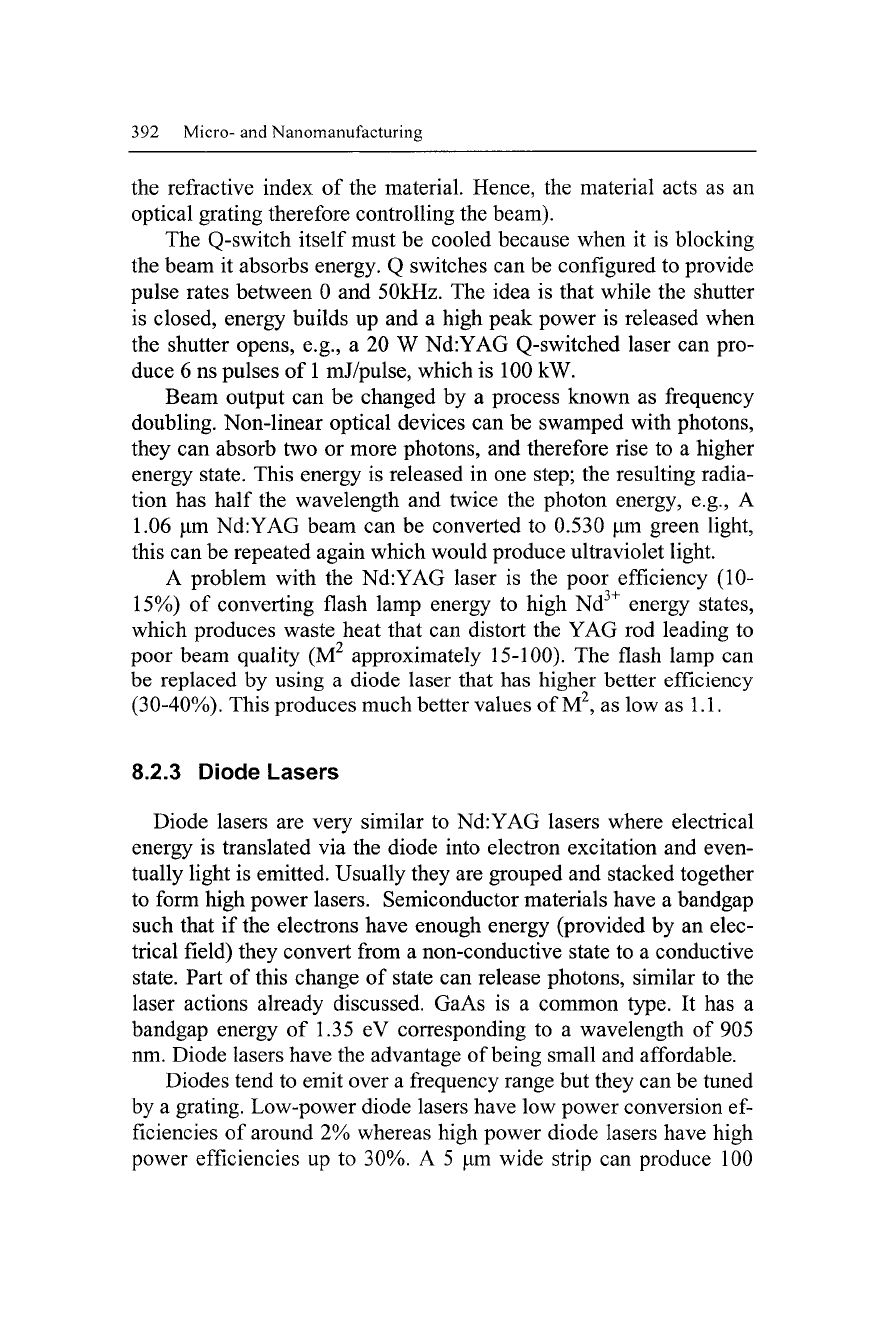
392 Micro- and Nanomanufacturing
the refractive index of the material. Hence, the material acts as an
optical grating therefore controlling the beam).
The Q-switch itself must be cooled because when it is blocking
the beam it absorbs energy. Q switches can be configured to provide
pulse rates between 0 and 50kHz. The idea is that while the shutter
is closed, energy builds up and a high peak power is released when
the shutter opens, e.g., a 20 W Nd:YAG Q-switched laser can pro-
duce 6 ns pulses of
1
mJ/pulse, which is 100 kW.
Beam output can be changed by a process known as frequency
doubling. Non-linear optical devices can be swamped with photons,
they can absorb two or more photons, and therefore rise to a higher
energy state. This energy is released in one step; the resulting radia-
tion has half the wavelength and twice the photon energy, e.g., A
1.06 |Lim Nd:YAG beam can be converted to 0.530 |iim green light,
this can be repeated again which would produce ultraviolet light.
A problem with the Nd:YAG laser is the poor efficiency (10-
15%) of converting flash lamp energy to high Nd^"^ energy states,
which produces waste heat that can distort the YAG rod leading to
poor beam quality (M^ approximately 15-100). The flash lamp can
be replaced by using a diode laser that has higher better efficiency
(30-40%).
This produces much better values of
M^,
as low as 1.1.
8.2.3 Diode Lasers
Diode lasers are very similar to Nd:YAG lasers where electrical
energy is translated via the diode into electron excitation and even-
tually light is emitted. Usually they are grouped and stacked together
to form high power lasers. Semiconductor materials have a bandgap
such that if the electrons have enough energy (provided by an elec-
trical field) they convert from a non-conductive state to a conductive
state.
Part of this change of state can release photons, similar to the
laser actions already discussed. GaAs is a common type. It has a
bandgap energy of 1.35 eV corresponding to a wavelength of 905
nm. Diode lasers have the advantage of being small and affordable.
Diodes tend to emit over a frequency range but they can be tuned
by a grating. Low-power diode lasers have low power conversion ef-
ficiencies of around 2% whereas high power diode lasers have high
power efficiencies up to 30%. A 5 |Lim wide strip can produce 100
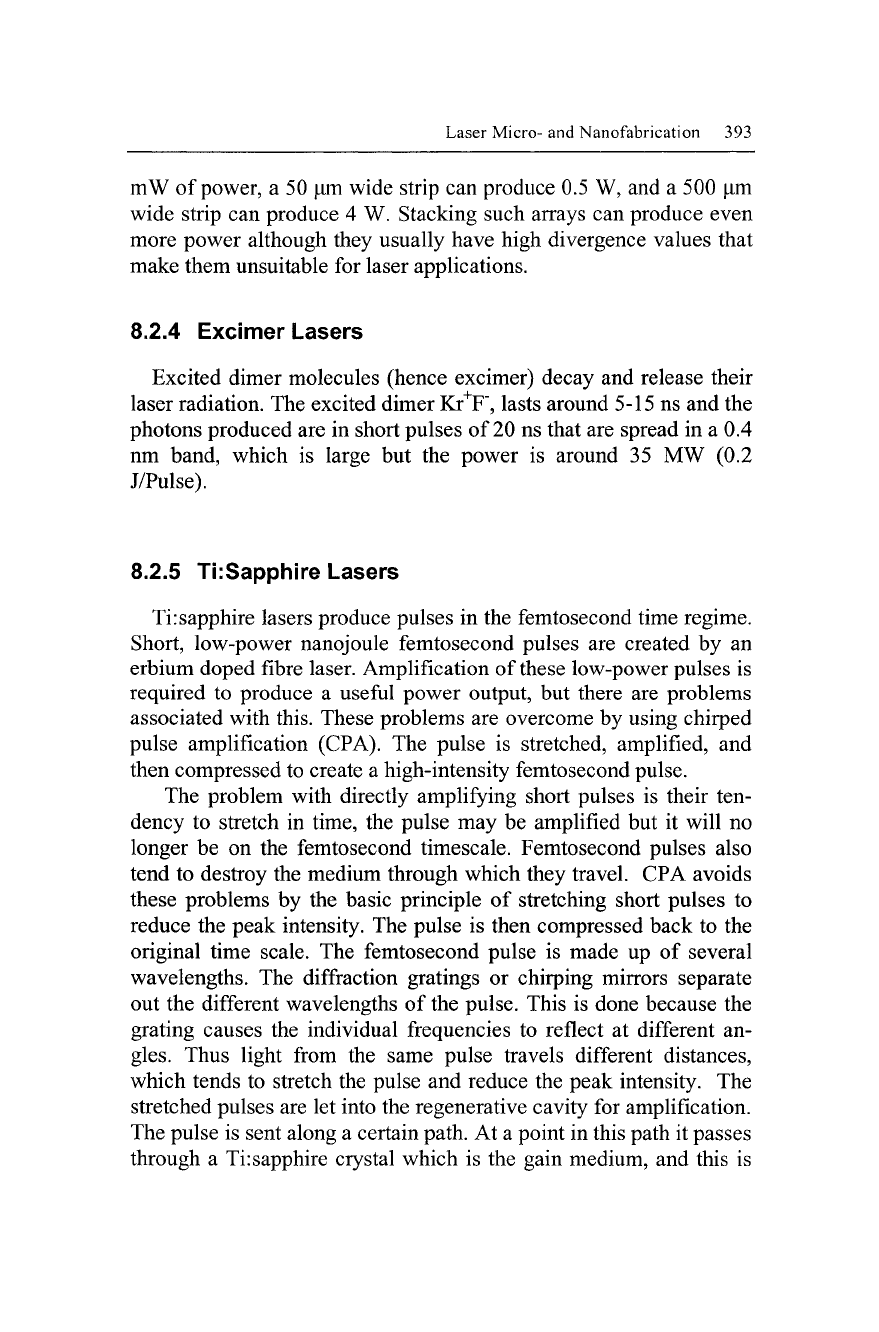
Laser Micro- and Nanofabrication 393
mW of power, a 50 |j.m wide strip can produce 0.5 W, and a 500 |Lim
wide strip can produce 4 W. Stacking such arrays can produce even
more power although they usually have high divergence values that
make them unsuitable for laser applications.
8.2.4 Excimer Lasers
Excited dimer molecules (hence excimer) decay and release their
laser radiation. The excited dimer
Kr'^F",
lasts around 5-15 ns and the
photons produced are in short pulses of
20
ns that are spread in a 0.4
nm band, which is large but the power is around 35 MW (0.2
J/Pulse).
8.2.5 ThSapphire Lasers
Ti:sapphire lasers produce pulses in the femtosecond time regime.
Short, low-power nanojoule femtosecond pulses are created by an
erbium doped fibre laser. Amplification of these low-power pulses is
required to produce a useful power output, but there are problems
associated with this. These problems are overcome by using chirped
pulse amplification (CPA). The pulse is stretched, amplified, and
then compressed to create a high-intensity femtosecond pulse.
The problem with directly amplifying short pulses is their ten-
dency to stretch in time, the pulse may be amplified but it will no
longer be on the femtosecond timescale. Femtosecond pulses also
tend to destroy the medium through which they travel. CPA avoids
these problems by the basic principle of stretching short pulses to
reduce the peak intensity. The pulse is then compressed back to the
original time scale. The femtosecond pulse is made up of several
wavelengths. The diffraction gratings or chirping mirrors separate
out the different wavelengths of the pulse. This is done because the
grating causes the individual frequencies to reflect at different an-
gles.
Thus light from the same pulse travels different distances,
which tends to stretch the pulse and reduce the peak intensity. The
stretched pulses are let into the regenerative cavity for amplification.
The pulse is sent along a certain path. At a point in this path it passes
through a
Ti:
sapphire crystal which is the gain medium, and this is
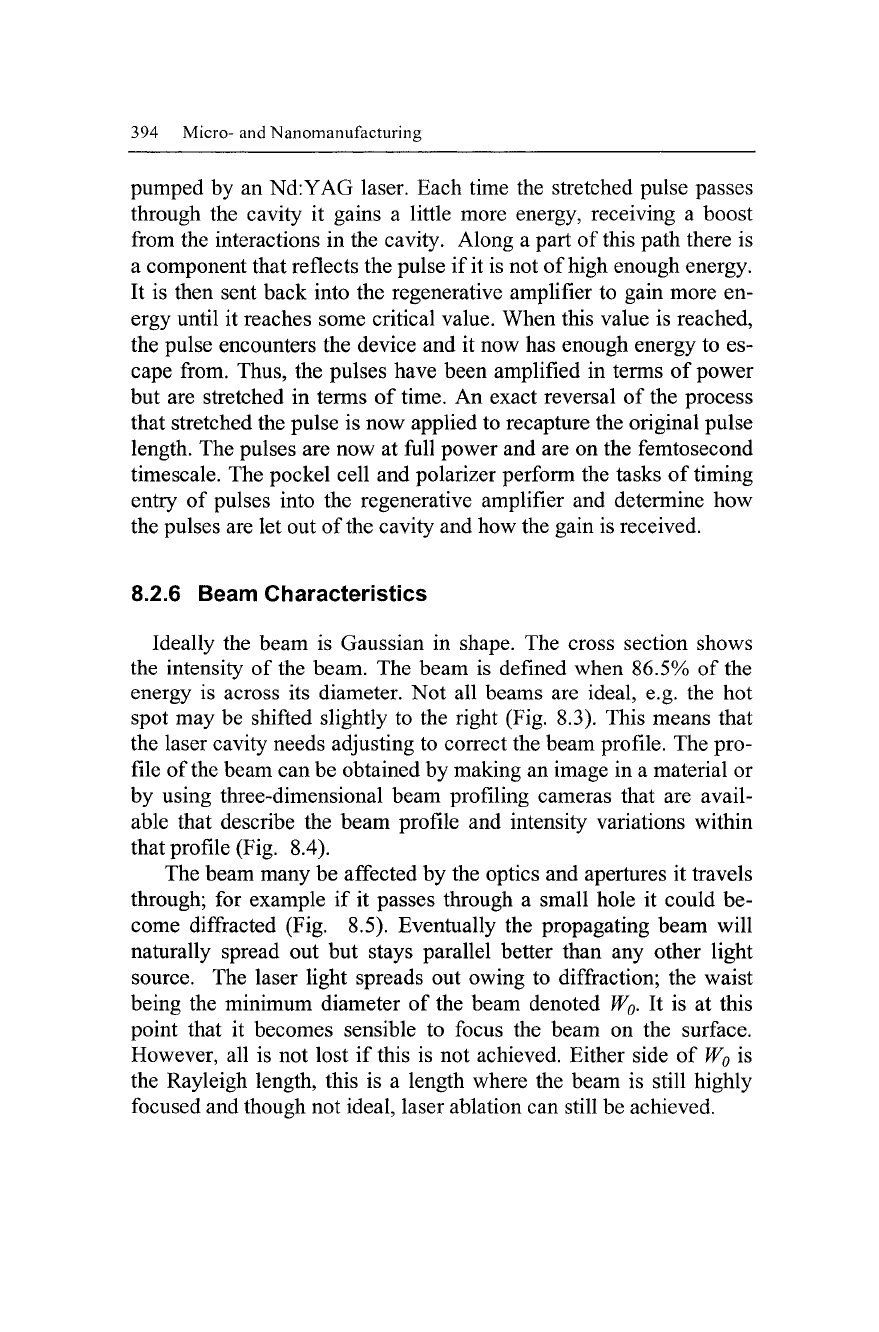
394 Micro- and Nanomanufacturing
pumped by an Nd:YAG laser. Each time the stretched pulse passes
through the cavity it gains a little more energy, receiving a boost
from the interactions in the cavity. Along a part of this path there is
a component that reflects the pulse if it is not of high enough energy.
It is then sent back into the regenerative amplifier to gain more en-
ergy until it reaches some critical value. When this value is reached,
the pulse encounters the device and it now has enough energy to es-
cape from. Thus, the pulses have been amplified in terms of power
but are stretched in terms of time. An exact reversal of the process
that stretched the pulse is now applied to recapture the original pulse
length. The pulses are now at full power and are on the femtosecond
timescale. The pockel cell and polarizer perform the tasks of timing
entry of pulses into the regenerative amplifier and determine how
the pulses are let out of the cavity and how the gain is received.
8.2.6 Beam Characteristics
Ideally the beam is Gaussian in shape. The cross section shows
the intensity of the beam. The beam is defined when 86.5% of the
energy is across its diameter. Not all beams are ideal, e.g. the hot
spot may be shifted slightly to the right (Fig. 8.3). This means that
the laser cavity needs adjusting to correct the beam profile. The pro-
file of
the
beam can be obtained by making an image in a material or
by using three-dimensional beam profiling cameras that are avail-
able that describe the beam profile and intensity variations within
that profile (Fig. 8.4).
The beam many be affected by the optics and apertures it travels
through; for example if it passes through a small hole it could be-
come diffracted (Fig. 8.5). Eventually the propagating beam will
naturally spread out but stays parallel better than any other light
source. The laser light spreads out owing to diffraction; the waist
being the minimum diameter of the beam denoted
WQ.
It is at this
point that it becomes sensible to focus the beam on the surface.
However, all is not lost if this is not achieved. Either side of
WQ
is
the Rayleigh length, this is a length where the beam is still highly
focused and though not ideal, laser ablation can still be achieved.
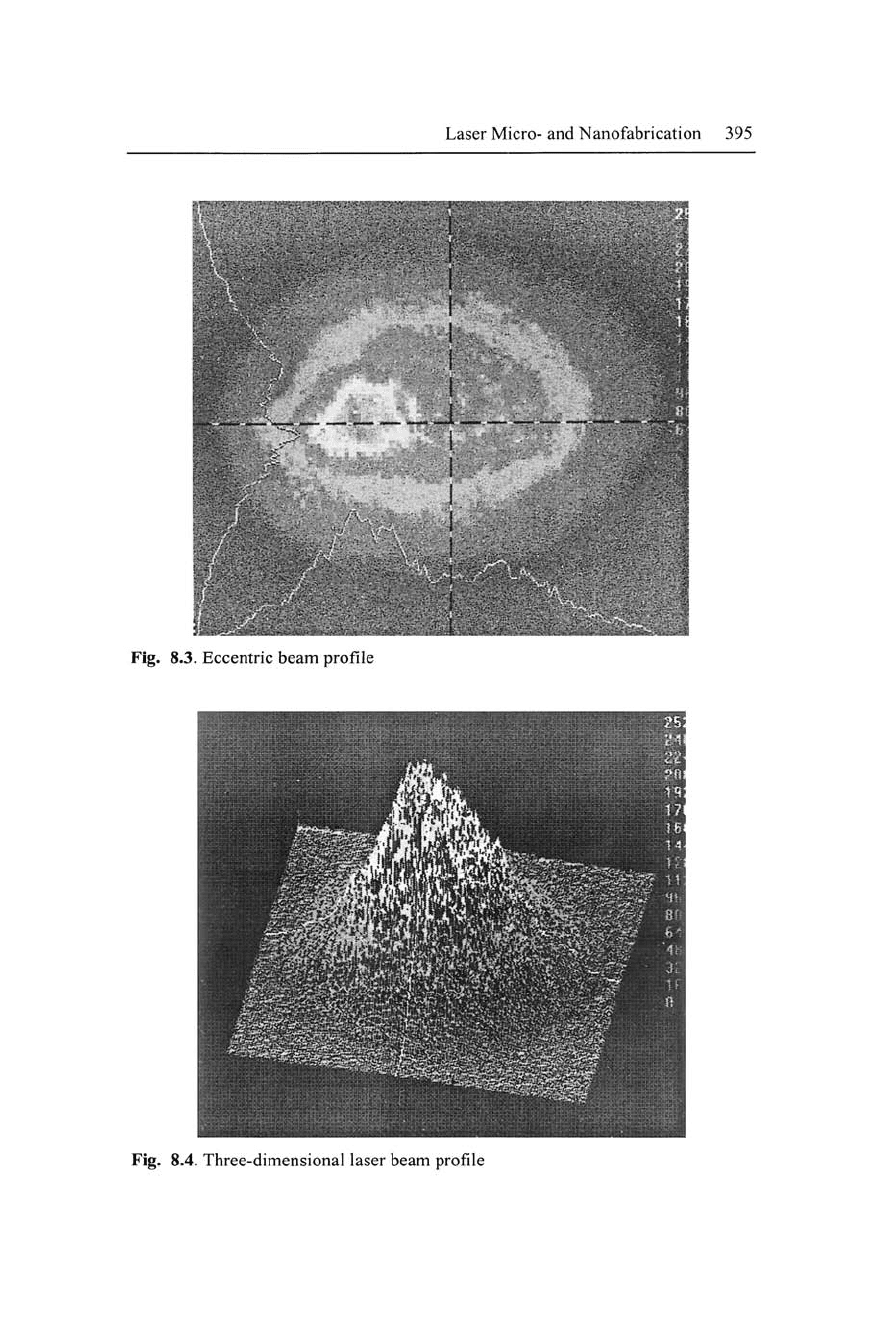
Laser Micro- and Nanofabrication 395
Fig. 8.3. Eccentric beam profile
Fig. 8.4. Three-dimensional laser beam profile
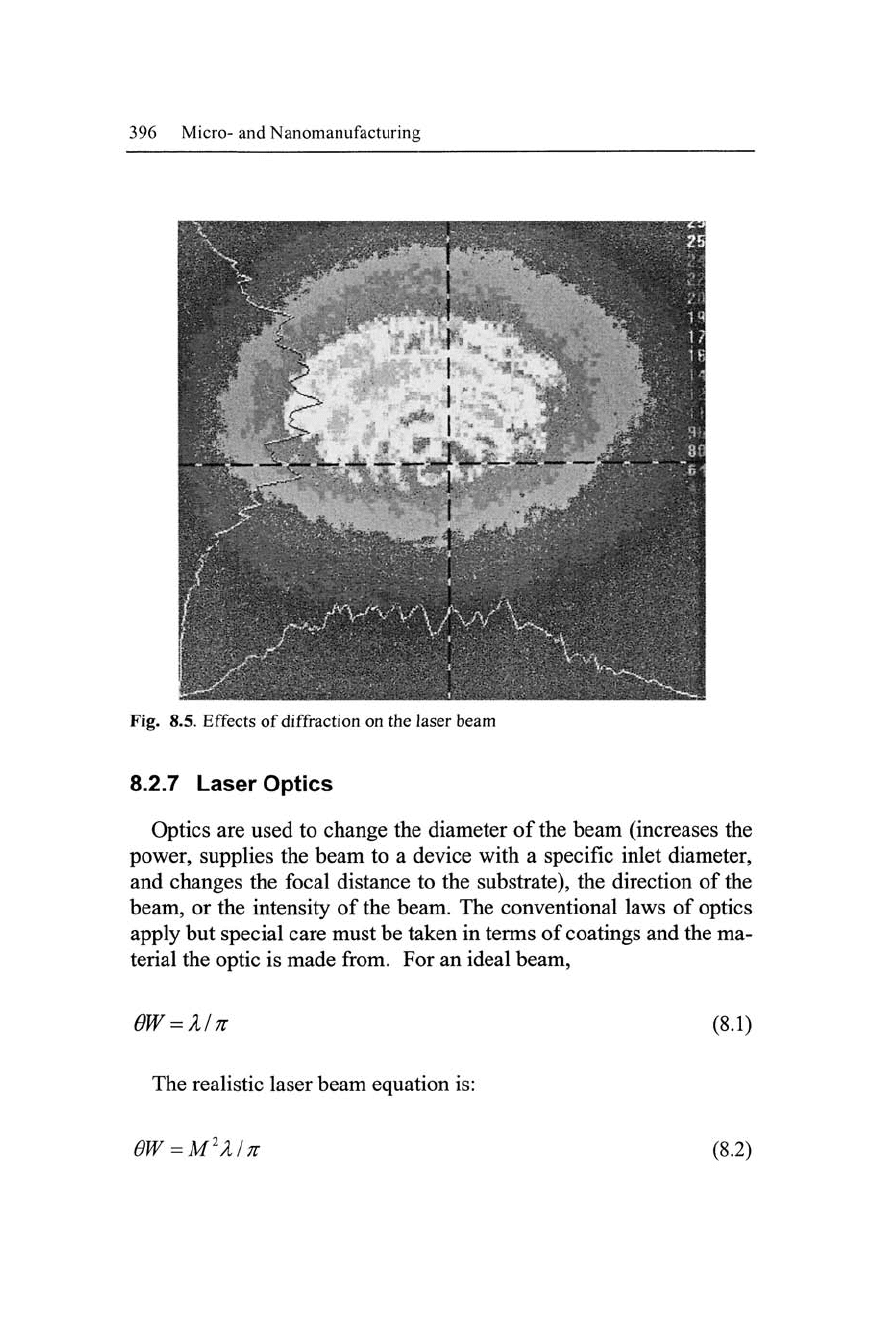
396 Micro- and Nanomanufacturing
Fig. 8.5. Effects of diffraction on the laser beam
8.2.7 Laser Optics
Optics are used to change the diameter of the beam (increases the
power, suppHes the beam to a device with a specific inlet diameter,
and changes the focal distance to the substrate), the direction of the
beam, or the intensity of the beam. The conventional laws of optics
apply but special care must be taken in terms of coatings and the ma-
terial the optic is made from. For an ideal beam,
ew=xi7r
(8.1)
The realistic laser beam equation is:
ew ^M^XIn
(8.2)
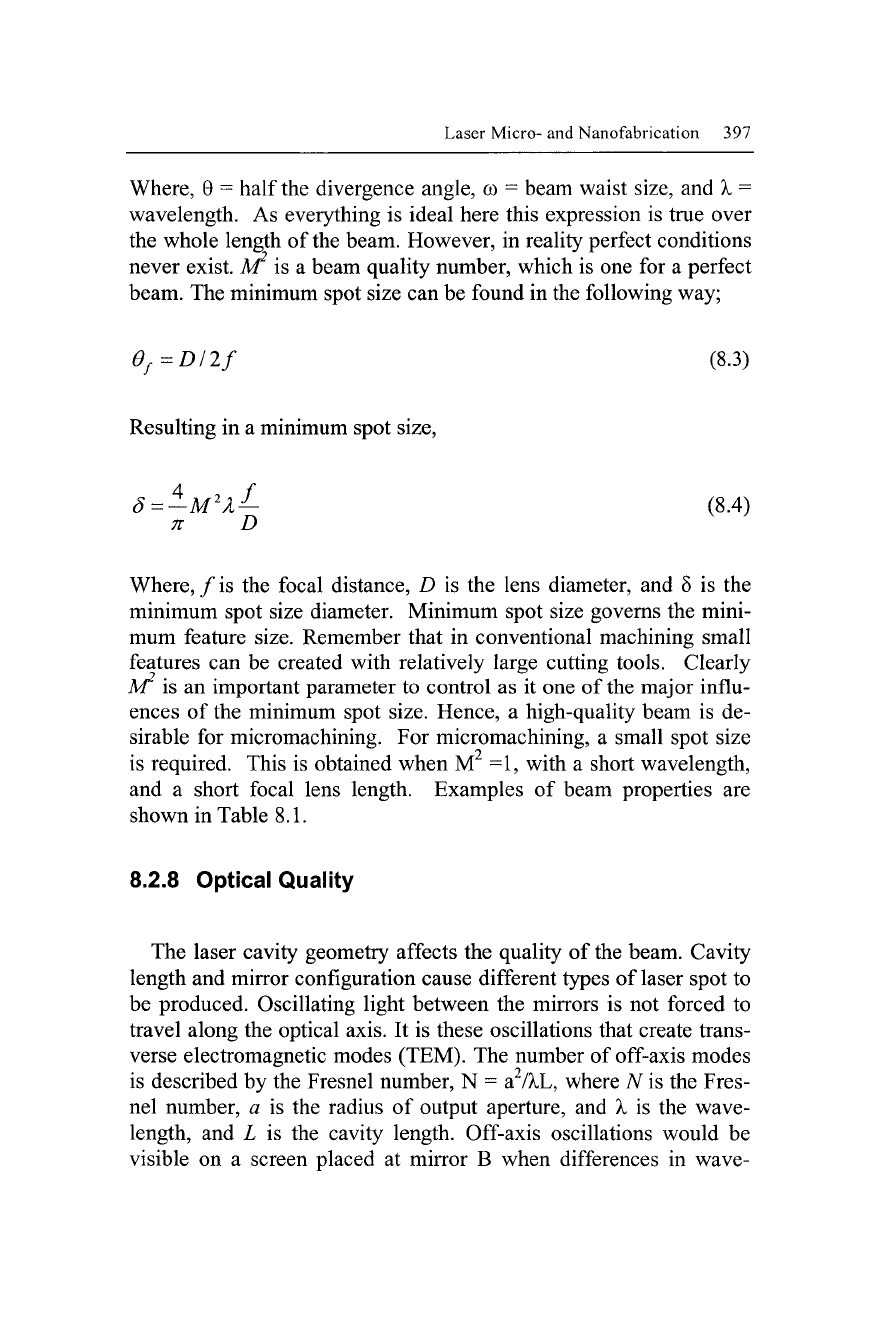
Laser Micro- and Nanofabrication 397
Where, 9 = half the divergence angle, o = beam waist size, and X =
wavelength. As everything is ideal here this expression is true over
the whole length of the beam. However, in reality perfect conditions
never exist, is a beam quality number, which is one for a perfect
beam. The minimum spot size can be found in the following way;
d^=D/2f
(8.3)
Resulting in a minimum spot size,
S
=
-M'A^ (8.4)
TT
D
Where, / is the focal distance, D is the lens diameter, and 8 is the
minimum spot size diameter. Minimum spot size governs the mini-
mum feature size. Remember that in conventional machining small
features can be created with relatively large cutting tools. Clearly
is an important parameter to control as it one of the major influ-
ences of the minimum spot size. Hence, a high-quality beam is de-
sirable for micromachining. For micromachining, a small spot size
is required. This is obtained when M^ =1, with a short wavelength,
and a short focal lens length. Examples of beam properties are
shown in Table 8.1.
8.2.8 Optical Quality
The laser cavity geometry affects the quality of the beam. Cavity
length and mirror configuration cause different types of laser spot to
be produced. Oscillating light between the mirrors is not forced to
travel along the optical axis. It is these oscillations that create trans-
verse electromagnetic modes (TEM). The number of off-axis modes
is described by the Fresnel number, N = a^/X,L, where
A^
is the Fres-
nel number, a is the radius of output aperture, and X is the wave-
length, and L is the cavity length. Off-axis oscillations would be
visible on a screen placed at mirror B when differences in wave-
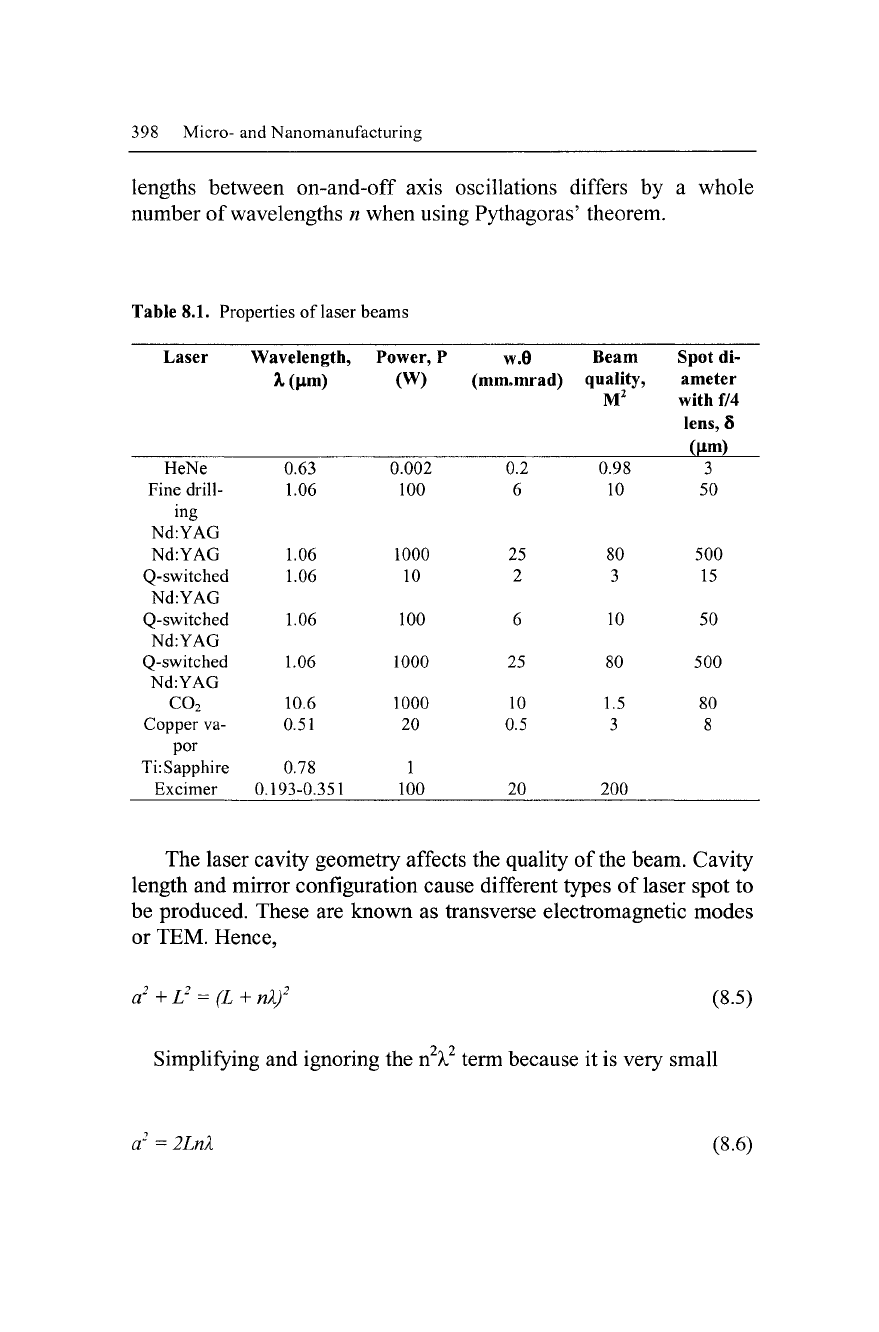
398 Micro- and Nanomanufacturing
lengths between on-and-off axis oscillations differs by a whole
number of wavelengths n when using Pythagoras' theorem.
Table 8.1. Properties of laser beams
Laser Wavelength, Power, P w.0 Beam
A,(^in) (W) (mm.mrad) quality.
Spot di-
ameter
with f/4
lens,
5
HeNe
Fine drill-
ing
Nd:YAG
Nd:YAG
Q-switched
Nd:YAG
Q-switched
Nd.YAG
Q-switched
Nd:YAG
CO2
Copper va-
por
Ti:
Sapphire
Excimer
0.63
1.06
1.06
1.06
1.06
1.06
10.6
0.51
0.78
0.193-0.351
0.002
100
1000
10
100
1000
1000
20
1
100
0.2
6
25
2
6
25
10
0.5
20
0.98
10
80
3
10
80
1.5
3
200
3
50
500
15
50
500
80
The laser cavity geometry affects the quality of
the
beam. Cavity
length and mirror configuration cause different types of laser spot to
be produced. These are known as transverse electromagnetic modes
or TEM. Hence,
a^
+L^
=
(L
+ nXf
(8.5)
2'^2,
Simplifying and ignoring the n X term because it is very small
a
= 2LnX
(8.6)
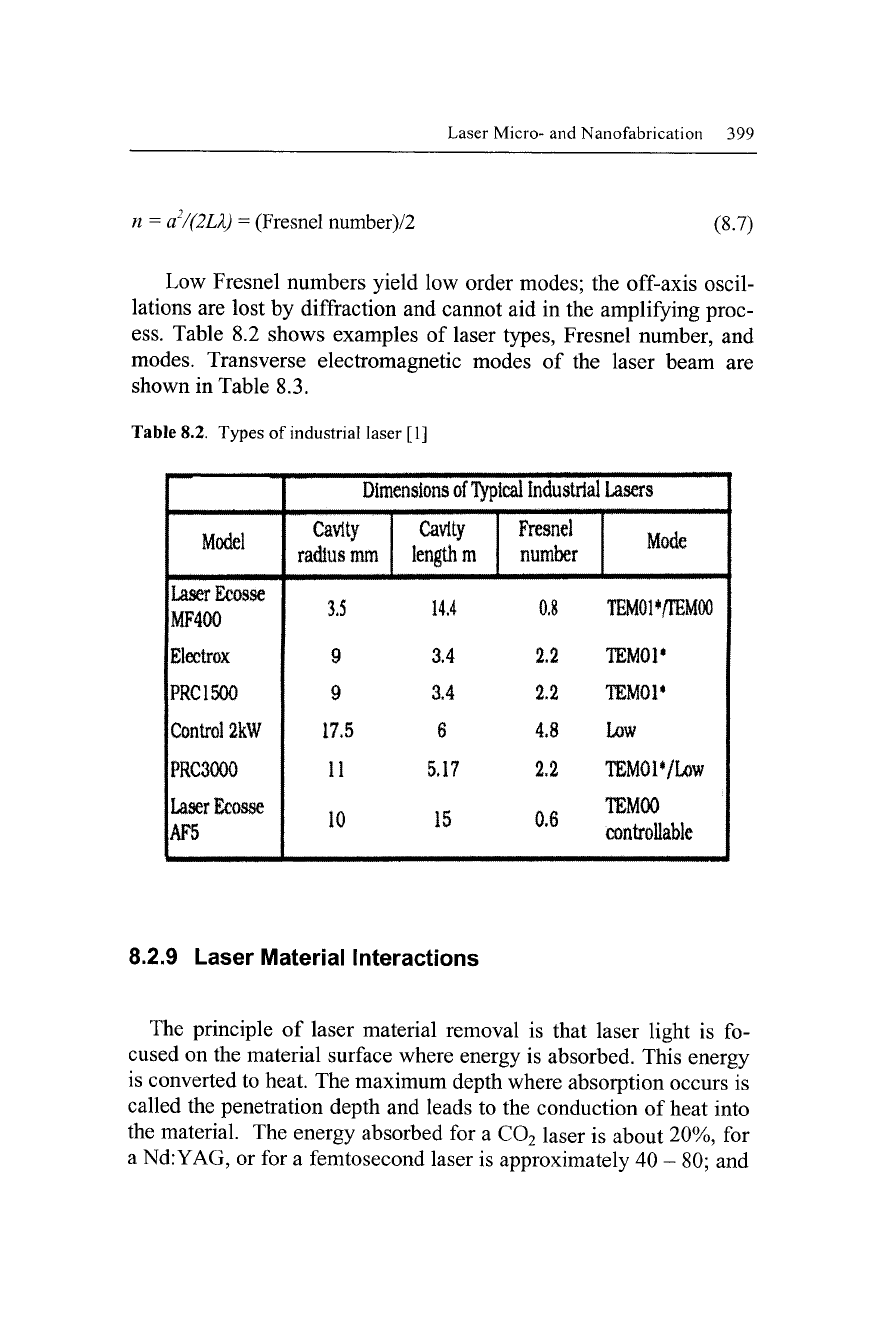
Laser Micro- and Nanofabrication 399
n
=
a^/(2LX)
=
(Fresnel number)/2
(8.7)
Low Fresnel numbers yield low order modes; the off-axis oscil-
lations are lost by diffraction and cannot aid in the amplifying proc-
ess.
Table 8.2 shows examples of laser types, Fresnel number, and
modes. Transverse electromagnetic modes of the laser beam are
shown in Table 8.3.
Table 8.2. Types of industrial laser [1]
Model
1 Laser Ecosse
MF400
Electrox
PRC1500
Control 2kW
PRC3000
Laser Ecosse
AF5
1 Dimensions of Typical Industrial Lasers
Cavity
radius mm
Cavity
length m
Fresnel
number
Mode
3.5
14.4 0.8
TEM01*/reM00
9
3,4 2.2
TEMOl*
9
3.4 2.2
TEMOl*
17.5
6 4.8 Low
11
5.17 2.2
TBMOlVLow
TEMOO
^°
^^ °-^
contronable
1
8.2.9 Laser Material Interactions
The principle of laser material removal is that laser light is fo-
cused on the material surface where energy is absorbed. This energy
is converted to heat. The maximum depth where absorption occurs is
called the penetration depth and leads to the conduction of heat into
the material. The energy absorbed for a CO2 laser is about 20%, for
a Nd: YAG, or for a femtosecond laser is approximately 40 - 80; and
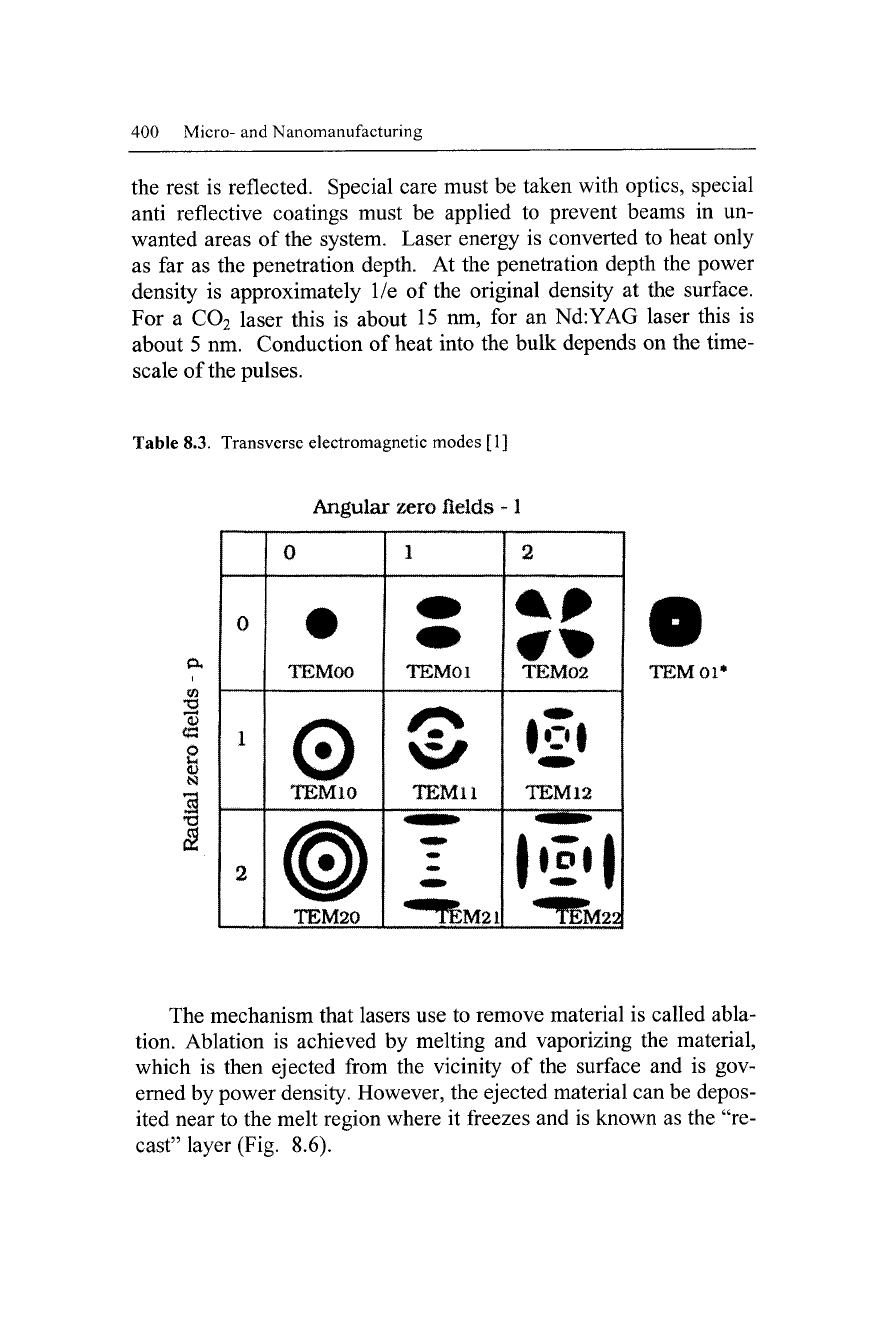
400 Micro- and Nanomanufacturing
the rest is reflected. Special care must be taken with optics, special
anti reflective coatings must be applied to prevent beams in un-
wanted areas of the system. Laser energy is converted to heat only
as far as the penetration depth. At the penetration depth the power
density is approximately 1/e of the original density at the surface.
For a CO2 laser this is about 15 nm, for an Nd:YAG laser this is
about 5 nm. Conduction of heat into the bulk depends on the time-
scale of the pulses.
Table 8.3. Transverse electromagnetic modes [1]
Angular zero fields -1
m
2
a
I
1
0
1
2
0
•
TEMOO
©
TKMlO
.TEM20 J
1
TEMOl
TEMU
""TlMail
2 1
1
^ #
TEMO2
TEM12
1
'i'
1
.'TsMy
TEMOl*
The mechanism that lasers use to remove material is called abla-
tion. Ablation is achieved by melting and vaporizing the material,
which is then ejected from the vicinity of the surface and is gov-
erned by power density. However, the ejected material can be depos-
ited near to the melt region where it freezes and is known as the "re-
cast" layer (Fig. 8.6).
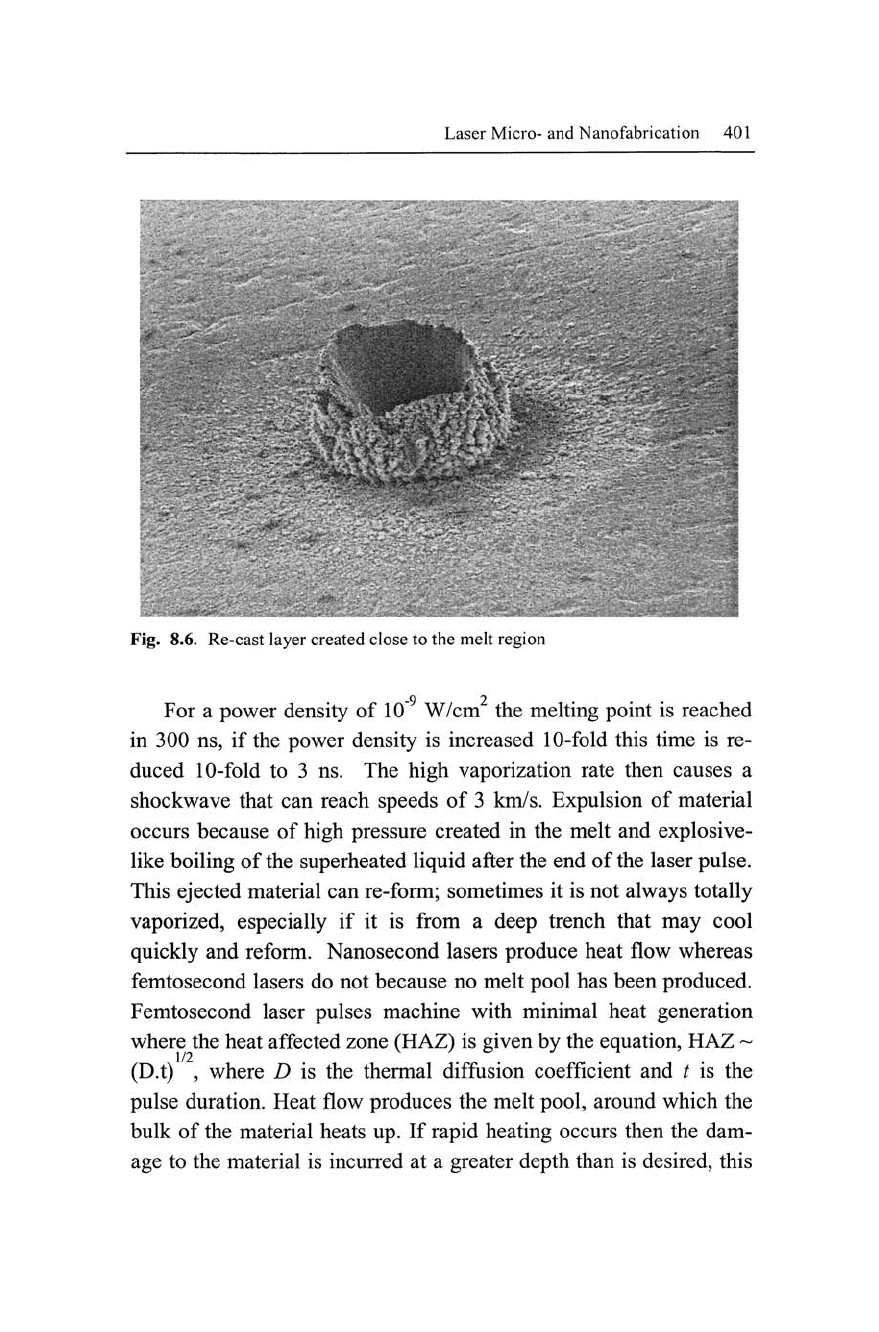
Laser Micro- and Nanofabrication 401
Fig. 8.6. Re-cast layer created close to the melt region
9 2
For a power density of 10" W/cm the melting point is reached
in 300 ns, if the power density is increased 10-fold this time is re-
duced 10-fold to 3 ns. The high vaporization rate then causes a
Shockwave that can reach speeds of 3 km/s. Expulsion of material
occurs because of high pressure created in the melt and explosive-
like boiling of the superheated liquid after the end of the laser pulse.
This ejected material can re-form; sometimes it is not always totally
vaporized, especially if it is from a deep trench that may cool
quickly and reform. Nanosecond lasers produce heat flow whereas
femtosecond lasers do not because no melt pool has been produced.
Femtosecond laser pulses machine with minimal heat generation
where the heat affected zone (HAZ) is given by the equation, HAZ ~
(D.t) , where D is the thermal diffusion coefficient and t is the
pulse duration. Heat flow produces the melt pool, around which the
bulk of the material heats up. If rapid heating occurs then the dam-
age to the material is incurred at a greater depth than is desired, this
